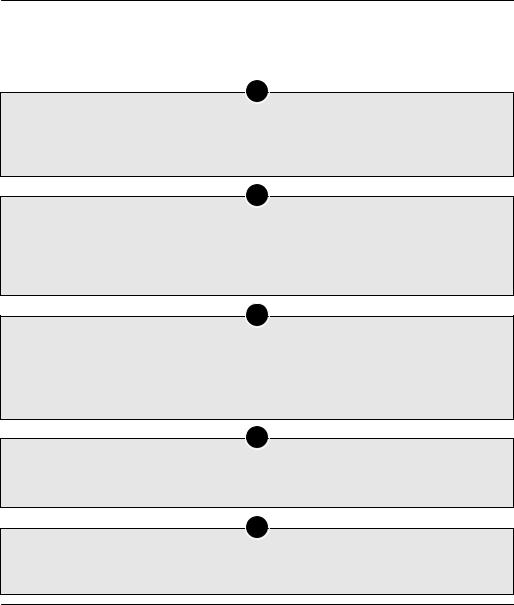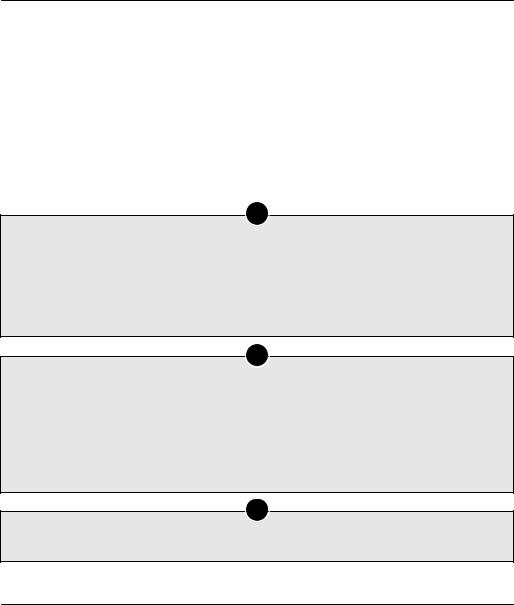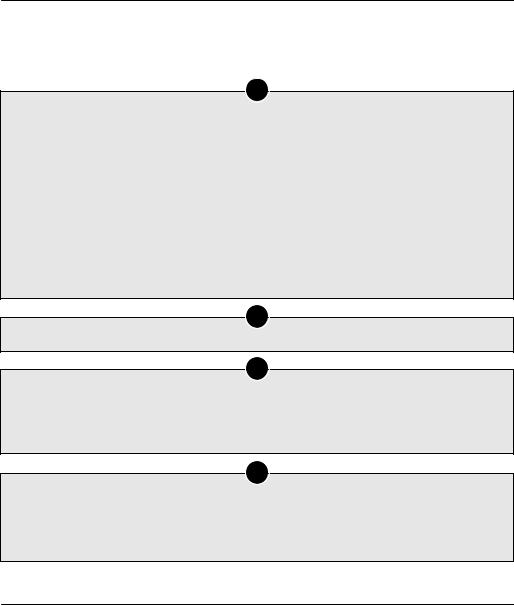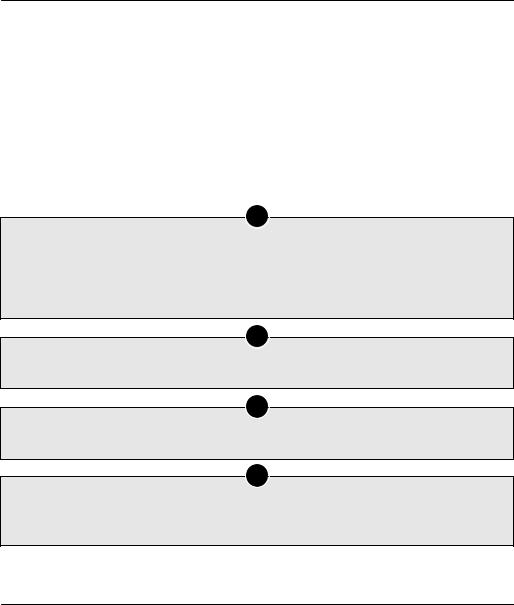
Books on Happiness / 365_Steps_to_Self-confidence-A_Programme_for_Personal_Transformation_in_Just_a_Few_Minutes_a_Day
.pdf
25
Calmness and confidence
Calmness and confidence are very closely related, and they start with physical relaxation. When your body is relaxed, your mind is calmer and clearer, you are more in control of your emotions and better able to relate to others. Physical relaxation and mental calmness help you cope with stressful situations, release unrealistic fears and anxieties, and improve concentration and creativity.
To acquire these benefits for yourself, you must practise:
1.Entering a peaceful, deeply relaxed state so that you can recharge your batteries. Make the most of techniques such as autosuggestion, mental rehearsal, anchoring and reframing
(see index).
2.Instant calmers. Learn to calm down instantly and stay calm, so that you can deal with awkward people and situations with ease.
Fortunately these skills are easily learned. Most of the early problems you may encounter will disappear if you practise daily, and you will soon be able to relax quickly and easily whenever you have the need.
And remember – the world won’t fall apart if you take it easy for a while!
1 1 0

C A L M N E S S A N D C O N F I D E N C E
‘If you are committed to your personal growth, you must have some quiet time to yourself every day. Make it a priority.’
David Lawrence Preston
*****
169
Practise this simple method of relaxation every day without fail until it comes naturally. It’s called The Five Deep Breaths Technique.
Take yourself to a quiet place where you will be undisturbed. Have a good stretch, then sit or lie down comfortably. Take a few deep breaths. Focus your gaze on a spot on the ceiling. When your eyes start to tire, let them close.
Now take a very deep breath. Say ‘one’ and let it out slowly, relaxing the eye muscles, face and neck. Pause for a moment, then take an even deeper breath. Say ‘two’ and let it out slowly, relaxing your shoulders, arms and hands. Pause and take a third deep breath. Say ‘three’ and let it out slowly, relaxing all the muscles in your legs and feet. Now take a fourth deep breath. Say ‘four’ and let it out slowly, relaxing all the muscles in your entire body.
Now take a fifth deep breath. Say ‘five’ and let it out slowly, whispering the word ‘relax’ under your breath. If you feel a little light-headed, or your arms and legs feel slightly heavy, good! Now, while you continue to go deeper into relaxation imagine you are in a quiet, peaceful place, such as a beach or garden, or in a special sanctuary or cosy country cottage. Put your thumb and fingers together and slowly whisper the following words several times:
‘One. Two. Three. Relax. Relax.’
If you practise every day, within a week or two you’ll be able to relax deeply whenever you wish. All you’ll have to do is close your eyes, take a deep breath, put your thumb and fingers together and quietly say, ‘One. Two. Three. Relax. Relax.’
1 1 1

3 6 5 |
S T E P S |
T O |
S E L F - C O N F I D E N C E |
170
This method is called Differential Relaxation. Make yourself comfortable, take a deep breath and close your eyes. Each time you breathe in, tense a group of muscles as hard as you can for five seconds. As you exhale, say the word ‘relax’ or ‘calm’ under your breath and feel the tension flowing out, leaving the muscles heavy and relaxed. Notice the difference between tension and relaxation.
Tense and relax the feet, curling your toes under as tightly as you can.
Tense and relax the lower legs.
Tense and relax the upper legs.
Tighten the hips and buttocks.
Tighten your stomach muscles.
Arch your back and tighten the muscles.
Tense and relax the hands, clenching your fists tightly.
Tense and relax the forearms, pushing outward as if pressing against an invisible wall.
Tense and relax the upper arms.
Bend your elbows and tense your biceps.
Shrug your shoulders up to your ears and relax them.
Tense and relax the neck.
Tense and relax the face, closing your eyes as tightly as you can, wrinkling the forehead
and drawing the corners of your mouth back.
Now imagine your body as a rag doll, limp and floppy, your muscles soft and loose, no tension. Slowly count down from ten to one on each out breath. You may also find it helpful to imagine some simple scene, somewhere full of peace and tranquillity, such as a place in the country, a garden, beach or special sanctuary.
1 1 2

C A L M N E S S A N D C O N F I D E N C E
171
When you are deeply relaxed repeat the following suggestions slowly to yourself. ‘I relax easily, quickly and deeply. Each time I relax, I go deeper
and deeper. My thinking is peaceful, calm and centred.’ This conditions your subconscious and helps you relax easily.
172
After each session, reflect on the relaxation.
How did you feel before you started?
What did you think about during the session?
Was your mind totally still at any point?
How do you feel now?
173
Breathing is the key to instant calmness and relaxation. Attention to your breath helps you to become aware of your body, focuses your concentration and brings your mind back to the present.
Take three very slow, deep breaths. Breathe out slowly, saying the word ‘relax’ under your breath, until your lungs are empty. Breathe normally for a few breaths. Then repeat the three slow breaths. Return to your activities feeling relaxed and calm.
174
Practise this. Take a deep breath and let it out slowly. Then repeat this affirmation: ‘I am cool, calm, confident and in control.’
The more you practise, the more effective it will be when you need it.
175
Write down this sentence:
‘As I become a calmer and more relaxed person, I am becoming aware...’ Quickly write down the first six thoughts that come into your head.
1 1 3

26
Anchoring
Anchoring is a way of drawing on past experiences in which you felt confident to help you cope better in the present. It’s another powerful weapon in your confidence armoury.
An anchor is any stimulus that consistently triggers an emotion. To use an anchor you have to:
Generate in yourself the particular set of feelings you wish to recreate.
Programme your subconscious to associate those feelings with specific words and gestures.
Use those words and gestures to trigger the desired feelings when required.
Sportsmen and women use anchors continually. For example, tennis players bounce the ball repeatedly before serving to calm themselves; most runners go through an elaborate routine to centre themselves, much of which is not strictly necessary to the actual performance; and the mighty All Black rugby team go through a series of rituals before each match to intimidate the opposition and fire themselves up.
You constantly anchor feelings in the nervous system whether you like it or not, so why not learn to use this to your advantage? Using anchors you can feel calm and confident, or energised and confident whenever you wish.
1 1 4

A N C H O R I N G
‘People tell me I’m lucky, but I’ve noticed the harder I practise, the luckier I get.’
Gary Player
*****
176
When you brought your thumb and fingers together and whispered One.Two.Three. Relax. Relax.’ (Confidence Builder No. 169) you were, in fact, installing an anchor.
Practise this every day until you are able to calm yourself down simply by taking a deep breath, placing your thumb and fingers together, breathing out slowly and saying ‘One. Two. Three. Relax. Relax.’ This will take a couple of weeks to perfect, but it’s well worth it. It’s a priceless skill.
177
Install an anchor which energises you.
Relax your body, and either recall or imagine a situation in which you felt 100% charged and at your best. Bring to mind all the associated sights, sounds, smells and physical sensations as vividly as possible.
Then ‘anchor’ those feelings. Choose a gesture you wouldn’t normally use (not the thumb and fingers, your subconscious associates this with calm). I use a clenched fist. Make the gesture and whisper a phrase such as ‘Yes! Yes! Yes!’
178
Keep practising and, within a few weeks, whenever you clench your fist and say, ‘Yes! Yes! Yes!’ you’ll feel a surge of energy, physical and emotional.
1 1 5

3 6 5 |
S T E P S |
T O |
S E L F - C O N F I D E N C E |
179
Choose an event you shortly have to face, when you need to remain calm, but you fear could bring on nervousness.
Start working on your anchor a few weeks before the event. Get into the relaxed state and recall a time when you felt really calm and confident. Relive it in as much detail as possible. If you can’t think of a suitable time just pretend to be confident. If you have a good imagination, your subconscious won’t know the difference.
When the feeling is strong, put your thumb and fingers together and gently whisper, ‘Cool, calm and confident’. The stronger the feeling, the more successful will be your anchor. Affirm that every time you make this gesture and repeat these words, these same calm, confident feelings will return.
This is called ‘installing the anchor’.
180
Practise anchoring every day until it comes easily to you. The more practice, the better.
181
Just before the actual event you were rehearsing in Confidence Builder 179, and if necessary during it, take a deep breath, put your thumb and fingers together and repeat your chosen phrase silently or aloud. Say it with conviction. Allow the confident feelings to flow through you. This is called ‘firing’ the anchor.
182
Alternatively, install an anchor when you experience good feelings as you go about your activities. This is effectively what athletes do when they raise their hands above their heads as they break the winning tape. If they were to do this repeatedly they would find that simply raising their hands above their heads would trigger those winning feelings.
1 1 6

A N C H O R I N G
‘Making up for lost time.’
Six years ago, Angela Dennett felt like a prisoner in her own home. Despite a debilitating back condition she was on full-time duty caring for her husband, who suffered from Altzheimer’s disease. When he died, she found herself with time on her hands, looking for something to get her out of the house.
As a young woman she would have liked a career in academia. She had a passionate interest in Ancient Egypt, but lacked confidence and grew up thinking it was beyond her. She ended up in a mind numbing office job.
One day Angela picked up a leaflet about the University of the Third Age (U3A), which provided educational and social activities for the over 50s. One of the courses was Creating Confidence. With trepidation she enrolled and diligently applied what she learned. Soon after the Membership Secretary’s job became vacant, and she put herself forward. A few months later, she was elected Chairman. ‘At first I was terrified,’ she said. ‘It takes a lot of confidence to control committee meetings, but I soon learned.’
It was then that her interest in Egyptology came to the fore. ‘After my husband died, I was able to study it properly. I enrolled for a degree course with the Open University, then I took the plunge and started teaching – l wouldn’t have had the confidence before. I gained a teaching certificate and am now a qualified adult education tutor.’
She regularly went to London to attend talks by the leading authorities. ‘One day I thought why should I have to travel all this way, so I started the Wessex Ancient Egypt Society. Now the experts come to us.’
Recently a dream came true when Angela was invited to visit Egypt. ‘I’d never flown before because I was too scared, but I wasn’t going to let that stop me, I used the techniques I’d learned on the confidence course – positive thinking, relaxation, visualisation and small steps to conquer my phobia. I was fine.’
‘As I see it, I’m in the second half of my life now, and fast trying to make up for lost time.’And how!
1 1 7

27
So far, so good
We’re just over half way now. What have you learned about confidence? More importantly, what have you learned about yourself? If you’ve understood what you’ve read so far and put it into practice, your confidence and self-esteem have already grown.
Take a pen and paper, and give yourself a mark out of ten, where ten means you feel you could achieve anything and zero that you feel useless at everything.
Now give yourself another mark out of ten, where ten means you feel worthy of good things and zero completely undeserving.
Now give yourself a mark out of ten for how well you relate to others.
Compare these marks with what you gave yourself six months ago (Confidence Builders 8, 9 and 10). See what I mean about your confidence and self-esteem having grown?
After pausing to take stock we’ll take a more in-depth look at the ITIA Formula©, introduce additional insights and techniques, then discuss skills that will help you to communicate confidently. Soon you’ll be ready to take on the world and pursue whatever your heart desires.
1 1 8

S O F A R , S O G O O D
‘By accepting yourself and joyfully being what you are, you fulfil your own abilities, and your simple presence can make others happy.’
Jane Roberts
*****
183
In Section 3 you made one of the most important decisions of your life: to work on your confidence and self-esteem. Reaffirm your promise to yourself to:
Always treat yourself with love and respect.
Act as if you could achieve anything you put your mind to.
Accept only the best for yourself.
184
Make a list of all the good things that have happened to you since you started reading this book. How many of them are due to your increased confidence?
185
List six ways in which your confidence has risen. What more needs to change? What are you doing to change them? What more do you need to do?
186
List six ways in which you are taking better care of yourself than you were six months ago, and six ways in which you could take even better care of yourself. Now put them into practice.
1 1 9
